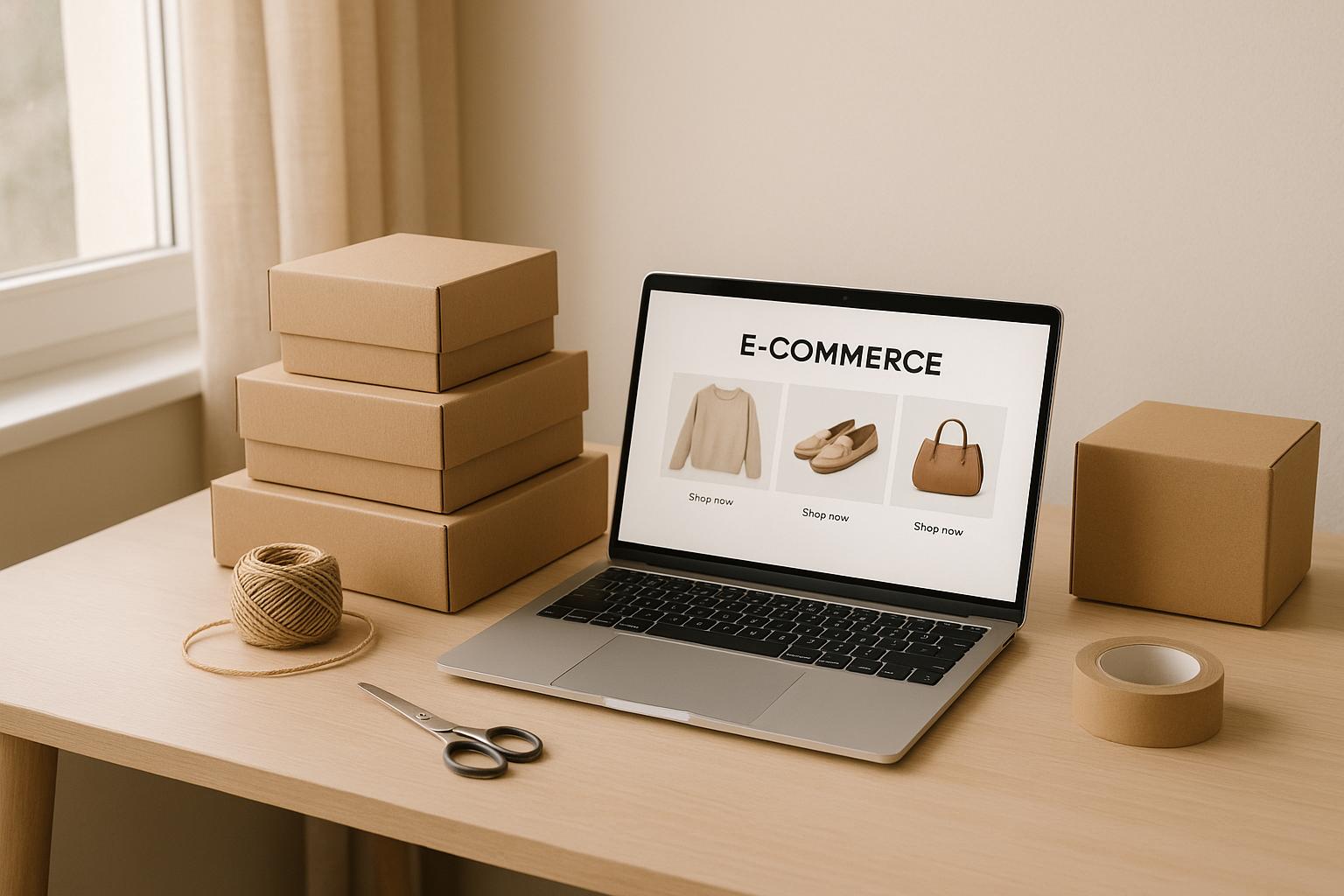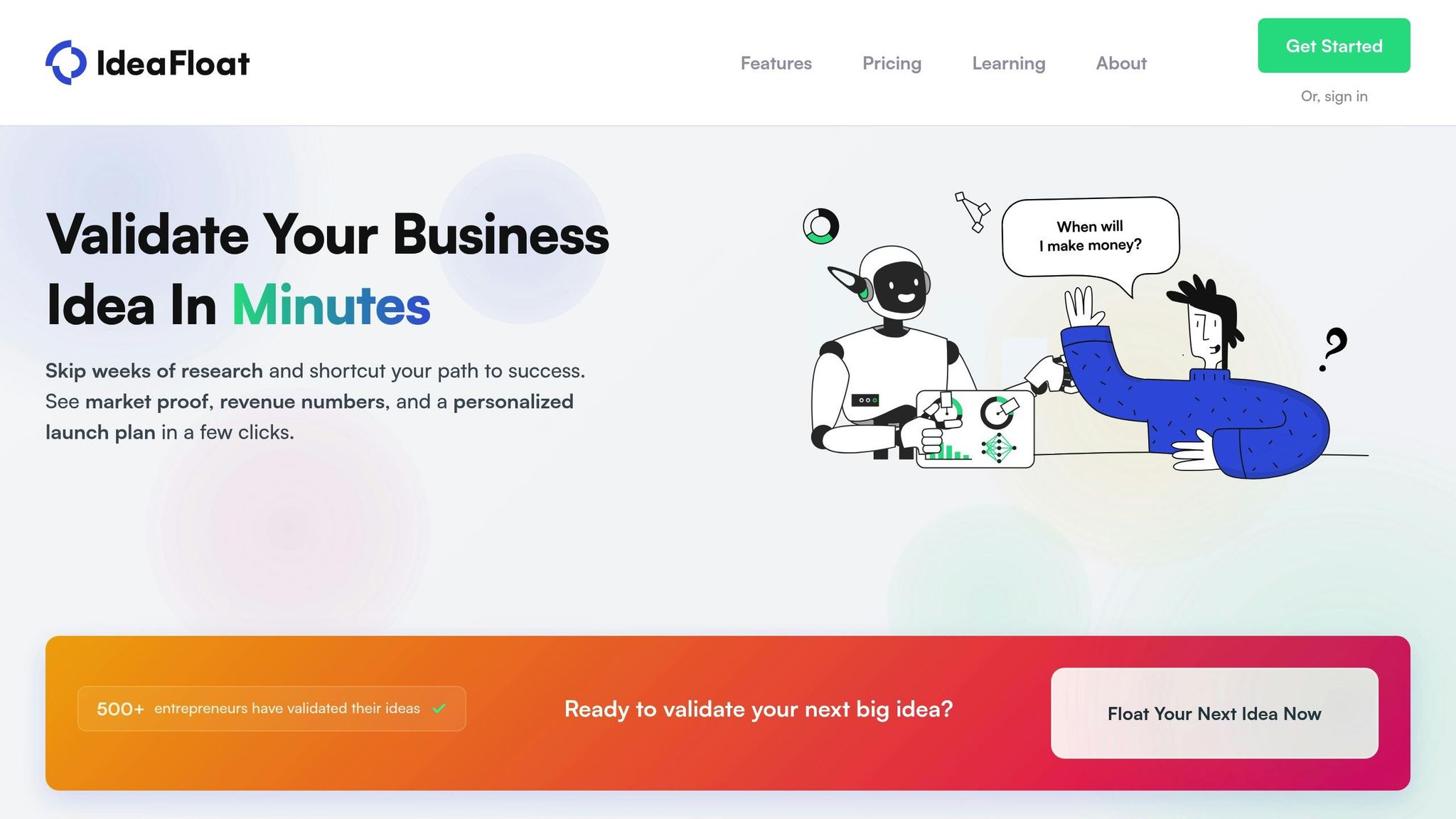
Starting an e-commerce business with just $300 is achievable if you focus on smart spending and simple strategies. Here’s how to break it down:
Key Steps:
- Choose a Business Model: Options include dropshipping (low inventory costs), print-on-demand (customizable products), or selling digital goods (low ongoing expenses).
- Budget Allocation:
- Platform & Tools: $50–80 for website hosting, domain, and basic apps.
- Product Sourcing: $100–150 for samples, designs, or digital content creation.
- Marketing: $80–120 for social media ads, email tools, and content creation.
- Business Essentials: $30–50 for registration and payment setup.
- Validate Your Idea: Use tools like IdeaFloat to test demand, analyze competitors, and refine your product strategy.
- Select a Platform: Shopify (easy setup) or WooCommerce (more control) are great options for beginners.
- Market Your Store: Leverage free or low-cost methods like social media, email marketing, and partnerships with micro-influencers.
Why It Works:
By sticking to a lean budget, you minimize risk while focusing on essentials like quality products and targeted marketing. This approach helps you launch quickly and adjust as you grow.
Next Steps:
- Validate your idea to ensure demand.
- Pick a platform that fits your needs.
- Start small, stay focused, and reinvest profits into scaling your business.
With $300 and the right plan, you’re ready to take the first step toward building your online store.
E-commerce Basics and How to Split Your $300 Budget
What is an E-commerce Business?
E-commerce allows you to run a virtual store that's open 24/7, giving you the chance to sell to customers across the globe - all without the hefty costs of a physical storefront. It's a flexible way to start a business with minimal overhead.
If you're starting with a $300 budget, here are three beginner-friendly business models to consider:
- Dropshipping: Sell products without keeping inventory. Your supplier ships items directly to your customers. While this keeps storage costs low, profit margins can be thinner.
- Print-on-Demand: Create custom designs for items like t-shirts, mugs, or phone cases. Companies like Printful or Gooten handle production and shipping as orders come in. This model requires creativity but offers competitive profit margins.
- Digital Products: Sell items like e-books, online courses, templates, or digital art. Once created, these products come with minimal ongoing costs and strong earning potential.
How to Split Your $300 Budget
With a clear understanding of e-commerce basics, let’s break down how to allocate your $300 for the best results.
| Category | Budget Allocation | Specific Costs |
|---|---|---|
| Platform & Tools | $50–80 | Website platform ($29/month), domain ($12/year), essential apps |
| Product Sourcing | $100–150 | Sample orders, design tools, or digital content creation |
| Marketing | $80–120 | Social media ads, content tools, email marketing services |
| Business Essentials | $30–50 | Business registration, legal fees, payment gateway setup |
- Platform & Tools: This includes your website subscription, a custom domain, and must-have tools like email marketing or design software.
- Product Sourcing: This will likely be your largest expense. For dropshipping, it covers sample orders to ensure quality. Print-on-demand businesses may need design tools and sample products. Digital products require resources for content creation.
- Marketing: Use this to attract your first customers. Invest in social media ads, content creation tools, and email marketing services to build awareness.
- Business Essentials: Allocate funds for proper registration, licensing, and setting up payment processing to keep your operations legitimate.
Every dollar in this budget serves as an investment in building a lean and scalable e-commerce business. Start small, keep $50–75 as a buffer for unexpected costs, and focus on gradual growth. Aim to cover at least two months of recurring expenses to ensure a smooth launch and early momentum.
Testing Your Business Idea with AI-Powered Tools
Why You Need to Test Your Idea First
Before diving into your $300 budget, it’s critical to make sure people actually want what you’re planning to sell. Skipping this step is a common mistake among entrepreneurs, often leading to wasted money on products or services that nobody needs.
Testing your idea upfront helps you avoid three big mistakes: offering something the market doesn’t want, mispricing your product, and targeting the wrong audience.
By validating your idea, you not only minimize risks but also gain clarity on how to position your product, what price customers are willing to pay, and where to find your target audience. This insight lays the groundwork for every decision you’ll make as you stretch your $300 budget.
Now that we understand why this step is so important, let’s look at how AI-powered tools can make the validation process faster and more effective.
How IdeaFloat Helps Test Your Idea

IdeaFloat simplifies the process of testing your business idea by using AI to deliver data-driven insights based on real market research.
The platform walks you through a step-by-step validation process that offers quick, actionable insights. If you want to go deeper, IdeaFloat provides a more comprehensive framework, breaking down your business concept over several focused sessions.
Here’s what IdeaFloat brings to the table:
- Problem Validator: This tool helps you determine if your idea addresses a real problem that people are willing to pay to solve. It measures how urgent the problem is and identifies early signs of genuine market interest. In other words, it tells you if customers care enough about your solution before you invest in building it.
- Consumer Insights: By scanning online communities and conversations, this tool uncovers how potential customers talk about their pain points. This information is a goldmine for crafting marketing messages that resonate with your audience later.
- Competitor Analysis: IdeaFloat automatically evaluates your competition, giving you a clear picture of their strengths, weaknesses, and the gaps in the market. This helps you avoid overly crowded spaces where your $300 budget might not stretch far enough.
- Smart Market Sizing: Using reliable data, this feature calculates your Total Addressable Market (TAM), Serviceable Addressable Market (SAM), and Serviceable Obtainable Market (SOM). These numbers tell you if your market is large enough to support a profitable business.
- Financial Model: These tools break down your business’s financial viability. You’ll learn how many units you need to sell to break even, what your monthly profit goals should look like, and whether your pricing strategy aligns with your target audience.
How To Dropship With ONLY $300 (Where To Spend The Money?)
Picking Low-Cost Platforms and Tools for Your Store
Now that you've confirmed your business idea, it's time to build your online store - all while sticking to that $300 budget. The platform you choose will act as the backbone of your store, so making the right decision here is crucial for both a smooth launch and steady growth down the line.
Choosing Your E-commerce Platform
When funds are tight, don’t just focus on upfront costs - think about the total expenses over the next few years. Some platforms might seem free or cheap to start but could hit you with higher monthly fees or transaction costs later.
Shopify is a major player in the U.S., holding a 27% market share, and offers over 8,000 apps to enhance your store’s functionality. It charges a monthly fee, but in return, you get hosting, security, payment processing, and sleek templates - all without needing technical expertise. It’s a great option if you want an easy, all-in-one solution.
WooCommerce, on the other hand, works a bit differently. It’s free to install on WordPress and gives you access to over 60,000 plugins through the WordPress directory. However, you’ll need to budget for hosting, a domain name, and possibly premium themes if you want advanced features. The upside? WooCommerce offers unmatched flexibility. If you’re comfortable navigating WordPress, you can customize nearly every aspect of your store.
For beginners on a shoestring budget, platforms like Ecwid and Sellfy offer free plans that let you dip your toes into e-commerce without spending a dime.
To decide which platform suits you best, think about your technical skills, the number of products you plan to sell, and whether you need specific customizations. If you want a hassle-free setup and don’t mind a recurring fee, Shopify is a solid pick. But if you’re looking for maximum control and are okay with a bit of a learning curve, WooCommerce might be the way to go.
Once you’ve chosen your platform, it’s time to find affordable tools to help you run your store efficiently.
Must-Have Tools That Don't Break the Bank
Your platform is just the starting point. To run your store like a pro, you’ll need additional tools - but that doesn’t mean you have to spend big. There are plenty of free or low-cost options that deliver great results.
For payment processing, most platforms come with built-in options. Compare transaction fees from providers like Shopify Payments, PayPal, and Stripe to see which one aligns best with your needs.
When it comes to design and branding, you can save a lot by using free tools. Canva is an excellent choice for creating logos, social media graphics, and marketing materials. Its free version covers most basic needs, and you can always upgrade later for more advanced features. As for product photography, you don’t need expensive equipment - just use a good smartphone camera and natural lighting to capture clean, professional-looking images.
Email marketing is crucial for building relationships with your customers. Platforms like Mailchimp offer free plans with drag-and-drop tools to create polished newsletters, making it a great starting point for new businesses.
Analytics and tracking tools are essential for understanding your audience. Google Analytics provides detailed insights about your visitors for free, and Google Search Console helps you track how people find your site through search engines. Both integrate easily with most e-commerce platforms and give you the data you need to make informed decisions.
For customer service, start simple. Most platforms include basic contact forms, but as your business grows, consider adding real-time chat tools to improve conversions.
Inventory management becomes more important as your store scales. If you’re dropshipping, your supplier might handle this for you. For physical products, look into free inventory tools like inFlow or Zoho Inventory. Both Shopify and WooCommerce also offer built-in inventory systems designed for small businesses.
The key is to start with free tools and upgrade only when absolutely necessary. Many successful e-commerce stores began with entirely free resources, only investing in premium tools as their revenue grew. This approach keeps your costs low while ensuring your store evolves alongside your business.
sbb-itb-08dd11e
Finding Products and Setting Up Your Operations
With your platform and tools ready to go, it’s time to tackle the next big steps: finding products and setting up smooth operations. While this stage can feel overwhelming for many new entrepreneurs, a well-thought-out plan can help you source quality products and establish efficient processes without breaking the bank. Let’s explore ways to align your sourcing methods with your product strategy and budget.
Affordable Ways to Source Products
If you’re working within a $300 budget, selecting a low-cost sourcing method is key. Each option comes with its own trade-offs in terms of upfront expenses, profit potential, and time commitment.
Dropshipping is a go-to for keeping costs low since you don’t need to stock inventory. Suppliers ship items directly to customers, cutting out storage expenses. However, profit margins are often slimmer, and shipping times - especially when using overseas suppliers like those on AliExpress - can stretch to several weeks, which may frustrate customers looking for faster delivery options.
Print-on-demand works similarly but focuses on custom-designed items such as t-shirts, mugs, and phone cases. Providers like Printful and Gooten handle production and shipping, allowing you to offer personalized products without the need for upfront inventory. This method often delivers moderate profit margins and faster shipping, particularly when using domestic production.
Wholesale purchasing involves buying products in bulk at discounted rates, which you can then resell individually. While this approach requires a larger initial investment, it can lead to better profit margins if you’re confident in the demand for your products. Platforms like Faire and Alibaba make it easier to connect with wholesalers, though minimum order requirements mean you’ll need to commit more funds upfront.
Private labeling is another option where you purchase generic products and rebrand them as your own. This strategy usually requires a higher initial investment but provides the opportunity to create a recognizable brand. Sellers aiming for long-term growth often lean toward this method.
Here’s a quick comparison of these sourcing methods:
| Sourcing Method | Upfront Cost | Profit Margin | Time Investment | Best For |
|---|---|---|---|---|
| Dropshipping | Minimal | Generally lower | Low | Testing product ideas quickly |
| Print-on-Demand | Minimal to low | Moderate | Moderate | Trying out custom designs |
| Wholesale Purchasing | Moderate | Potentially higher | High | Selling products with proven demand |
| Private Labeling | Higher | Variable | Significant | Building a long-term brand |
For those sticking to a $300 budget, print-on-demand offers a balanced approach. It allows you to test various designs with minimal risk while keeping costs manageable.
Managing Inventory and Shipping
Even if you’re not holding physical inventory, efficient order management and shipping are crucial. Systems for tracking orders, communicating with customers, and handling returns will keep your operations running smoothly.
Start by tracking orders manually with a simple spreadsheet. This helps you monitor sales trends and resolve issues until you’re ready to invest in automation tools.
Your shipping strategy should align with your sourcing method. For dropshipping, especially from overseas, clearly communicate estimated delivery times on your product pages. Offering expedited shipping options, like ePacket, can shorten delivery times for an additional fee, which some customers may gladly pay.
For print-on-demand services, providers like Printful often include standard and expedited shipping options. Highlighting the benefits of faster delivery can improve the customer experience while boosting your margins.
Don’t overlook return policies - they’re essential for building trust. Many print-on-demand providers handle returns for defective items, but you’ll need to decide how to address issues like design preferences or sizing. A 30-day return window for unused items, with customers covering return shipping, strikes a fair balance between customer satisfaction and protecting your bottom line.
Customer communication doesn’t have to be complex. Automated emails for order confirmations, shipping updates, and delivery notifications can keep customers informed. As your business grows, consider adding a tracking page where customers can check their order status.
Lastly, even if you’re not physically handling products, quality control is non-negotiable. Ordering samples is a smart move to ensure the quality, sizing, and overall standards of the items you plan to sell. Keep detailed records of supplier performance and customer feedback - this will help you identify reliable partners as you expand your product line. Once your operations are in place, you’ll be ready to shift focus to budget-friendly marketing strategies to attract customers.
Launching and Marketing Your Store Under $300
Once you've streamlined your operations and secured your product sources, it's time to focus on what really matters - getting people to notice your store. Marketing on a tight budget might seem challenging, but with a bit of creativity and smart planning, you can achieve results without overspending. The trick? Use methods that pack a punch without draining your wallet.
Low-Cost Marketing Methods That Deliver Results
Social media platforms like Instagram, TikTok, and Facebook are your go-to tools for affordable marketing. Instead of splurging on polished ads, focus on authentic content. For example, showcase real-life product demos. If you're running a print-on-demand business, share behind-the-scenes videos of your design process. A time-lapse of you bringing a design to life or a quick explanation of its inspiration can resonate with your audience. Even better, show how your products fit into everyday life - this builds trust and sets your brand apart from generic competitors.
Email marketing is another cost-effective powerhouse. Tools like Mailchimp offer free plans for up to 2,000 subscribers, making it perfect for new businesses. Start building your email list from day one by offering a small perk, like a 10% discount or early access to new products, in exchange for an email address. Once you've got your list, keep it simple. A weekly email featuring product highlights, behind-the-scenes updates, or a warm welcome series introducing your brand can go a long way. Consistency is key - one well-crafted email each week beats a sporadic flood of messages.
Influencer partnerships are within reach, even with a small budget. Micro-influencers - those with 1,000 to 10,000 followers - often have highly engaged audiences and are more likely to collaborate in exchange for free products. Personalize your outreach to show why your product is a good fit. For instance, a fitness influencer might love your motivational t-shirts, while a coffee enthusiast could showcase your custom mugs. Authentic endorsements from these creators can drive real interest in your store.
Content marketing is a long-term strategy that pays off over time. Blogging or creating videos around your niche can draw steady traffic to your store. Selling kitchen gadgets? Share quick and easy recipe videos. Offering fashion items? Create styling guides or lookbooks for the season. This type of content not only helps potential customers but also boosts your visibility on search engines.
Community engagement is another budget-friendly way to spread the word. Join Facebook groups, Reddit threads, or Discord servers where your target audience hangs out. The key is to be genuinely helpful - answer questions, share useful tips, and build relationships. When the moment feels right, you can naturally mention your products, making your pitch feel authentic rather than pushy.
If you're looking for tools to simplify your launch and marketing efforts, IdeaFloat could be a game-changer.
How IdeaFloat Can Help You Launch on a Budget
When you're working with limited funds, every move counts. IdeaFloat offers tools designed to make your launch smooth and effective without breaking the bank. Here's how it can help:
- Community Launch Map: This tool helps you find active buyer groups and provides pre-written posts that spark genuine conversations, avoiding the spammy vibe.
- Waitlist Landing Page: Build excitement for your store by capturing email addresses from visitors who want early access to your launch.
- Launch Checklist: Keep your marketing efforts in sync with a coordinated, step-by-step plan to ensure nothing falls through the cracks.
- Logo Generator and Branding Guide: Create a professional look for your store that builds trust, all without hiring expensive designers.
These tools save you time and effort, helping you connect with potential customers right from the start. Having a list of excited buyers ready to go on launch day can make all the difference between a slow start and a successful debut.
In e-commerce, first impressions are everything. Consistent, polished branding across all your platforms can boost conversion rates without costing a fortune. And while it takes patience and persistence to market on a tight budget, focusing on genuine connections with your audience will pay off in the long run. Over time, your efforts will build momentum and drive sales.
Conclusion: Main Points and What to Do Next
Launching an e-commerce business on a $300 budget is not just possible - it can be done effectively with the right strategy. The secret lies in smart budget allocation: set aside $100 for essential tools and platforms, $150 to set up your products, and $50 for marketing. This plan ensures you have the basics covered without overspending.
Start by validating your business idea. Before committing to inventory, use tools like IdeaFloat to gauge market demand. This step can save you from pouring money into products that might not sell. It's a simple way to test the waters without taking on unnecessary risk.
When choosing a platform, prioritize value. Look for options that fit your budget, whether it’s an all-in-one hosted solution or a WordPress setup. Avoid locking yourself into high monthly fees early on; you can always upgrade once your business starts gaining traction.
For product sourcing, consider cost-effective methods like print-on-demand or dropshipping. These approaches let you test your ideas without the need for upfront inventory costs. Start small and scale as you learn what works.
Your marketing strategy doesn’t have to break the bank, either. Focus on free or low-cost methods like social media, email campaigns, and engaging with online communities. Authentic, consistent content often performs better than sporadic, overly polished posts. The key is to stay active and relevant to your target audience.
What’s the next step? Begin by validating your business idea with IdeaFloat’s tools. Features like the Problem Validator, Consumer Insights, and Competitor Analysis can help you confirm market demand. Once you’re confident in your concept, use tools like the Logo Generator and Waitlist Landing Page to establish your brand and start building a customer base - even before your official launch.
The most important part is to start. Entrepreneurs who succeed are those who take that first step, learn from their experiences, and adjust as they go. With just $300 and the strategies outlined here, you’re equipped to launch your e-commerce business. The biggest risk? Not starting at all.
Take that first step today - your e-commerce journey is waiting.
FAQs
How can I make sure my e-commerce business idea will succeed before spending my $300 budget?
Before diving into investing your $300 budget, it’s smart to take some time to validate your e-commerce business idea. Start with market research to get a clear picture of your target audience, understand the demand for your product, and see how your competitors are operating. Look for a niche that has opportunities for growth but doesn’t feel overcrowded with competition.
Next, try conducting a SWOT analysis. This will help you map out your strengths, weaknesses, potential opportunities, and any threats you might face. To test if there’s real interest in your product, you could run a simple pre-order campaign or list your product on platforms like Amazon or eBay. This way, you can gauge demand without overcommitting. These steps will help you make smarter choices and set your business up for the best chance of success.
What are the pros and cons of using Shopify vs. WooCommerce for starting an e-commerce business on a $300 budget?
If you’re launching an e-commerce business with a $300 budget, both Shopify and WooCommerce offer solid options, each with its own pros and cons.
Shopify is perfect if you’re looking for something straightforward and quick to set up. It takes care of hosting, security, and other technical aspects, making it a great choice for beginners. However, while it’s convenient, the monthly subscription fees and potential extra costs for apps or transaction fees can stack up over time.
On the other hand, WooCommerce - a free plugin for WordPress - offers more flexibility and customization options. It’s a cost-effective choice upfront, but it does require you to manage hosting and other site-related tasks yourself. This hands-on approach might be a bit overwhelming if you’re new to web development.
Ultimately, the decision comes down to what matters most to you: ease of use and convenience (Shopify) or budget-friendly control and flexibility (WooCommerce).
What are the best ways to market my e-commerce store on a small budget without losing quality or reach?
Marketing your e-commerce store on a limited budget doesn’t mean you have to compromise on results. By leveraging organic strategies like SEO and content marketing, you can increase your website’s visibility without breaking the bank. These methods help attract traffic naturally and build long-term credibility.
Social media is another powerful ally. Use platforms like Instagram, Facebook, or X (formerly Twitter) to connect with your audience. Post engaging content - think polls, Q&A sessions, or behind-the-scenes glimpses - to create a sense of community and expand your organic reach.
Don’t overlook email marketing. It’s one of the most cost-effective tools out there, offering a great return on investment. A well-crafted email campaign can nurture customer relationships, drive repeat purchases, and keep your audience informed about new offers or products.
Lastly, allocate a small portion of your budget to experiment with new strategies or platforms. Testing different approaches allows you to discover what resonates most with your audience, helping you refine your efforts over time. With smart planning and resourceful tactics, you can grow your business without overspending.
Related Blog Posts
Get the newest tips and tricks of starting your business!


